by Amineddoleh & Associates LLC | Dec 21, 2021 |
In this inaugural newsletter, Amineddoleh & Associates is pleased to share some major developments that took place at the firm during the summer and autumn of 2021.
LITIGATION UPDATES
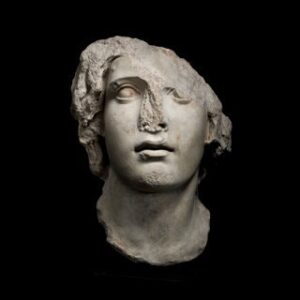
Ancient marble bust contested in lawsuit
Image from Manhattan DA’s Office
A Victory for Our Client, the Republic of Italy
Amineddoleh and Associates secured a win for its client, the Italian Republic, in the ongoing Safani v. Republic of Italy litigation in the U.S. District Court for the Southern District of New York. The court dismissed litigation against our client in a case concerning an Italian antiquity seized from a Manhattan art gallery. Read about the litigation update here and the case details here.
(The Plaintiff has since filed a Second Amended Complaint, naming the Manhattan District Attorney as a defendant in the case.)
ART & IP NEWS
Illicit Antiquities Trafficking
In this blog post, our founder Leila Amineddoleh discusses disgraced art dealer Nancy Wiener, who revealed new details about her involvement in the illicit trafficking of antiquities and its effect on the art market in an allocution statement. Wiener had ties to Douglas Latchford, whose recent appearance in the Pandora Papers leak highlights the global nature of the illicit antiquities trade. Read more on our website.
Nazi-Era Looting, Duress Sales, and New Laws
There were a number of developments this autumn concerning Nazi-Era looting. We presented an entry in our popular Provenance Series to examine the issues surrounding the restitution of looted cultural heritage in Poland, including the country’s history, a new law shortening the applicable statute of limitations, and examples of successful returns. Read more on our website. In addition, questions continue to arise concerning alleged duress sales, with one painting in Houston’s Museum of Fine Arts coming under scrutiny. Founder Leila Amineddoleh discussed the case and its implications with media outlets.
Turkey and Antiquities Restitution
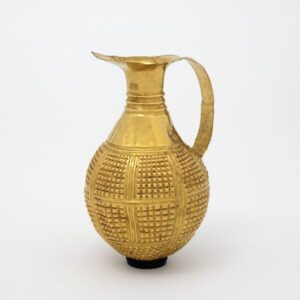
Gold ewer
Image from V&A
Firm founder Leila Amineddoleh consulted with the Gilbert Trust at the Victoria & Albert Museum concerning a 4,250 year old golden ewer that was returned to Turkey in October. The ewer was purchased by a private collector who was unaware of the seller’s dirty dealings, including his involvement in antiquities trafficking. Luckily, the Gilbert Trust was proactive and the matter was resolved amicably and creatively. Read about the ewer’s fascinating history and the details of its return here.
NFT Battle: Miramax v. Tarantino
With the ongoing NFT craze, market participants and legal scholars have been waiting for guidance from courts concerning the application of “traditional” intellectual property law to this new digital asset class. We authored a blog post discussing the legal questions and controversies arising as the NFT market continues to grow. NFTs recently made headlines when Miramax sued Quentin Tarantino. Tarantino, the award-winning movie director, announced his plan to sell a new NFT collection consisting of seven tokens to uncut, exclusive scenes from Pulp Fiction. In response, Miramax sued Tarantino for breach of contract, as well as copyright and trademark infringement. Read more about NFTs and this new lawsuit here.
Lifetime Ban on Collecting: the Steinhardt Seizure
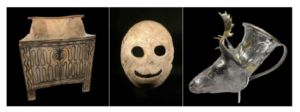
Several artifacts seized from Steinhardt
Image from DA’s Office
This blog post details the Manhattan District Attorney’s Office seizure of 180 looted antiquities from Michael Steinhardt. Steinhardt, a hedge-fund pioneer and one of the world’s most prolific collectors of ancient art, was involved in a criminal investigation examining issues with the provenance of various pieces in his collection. The DA’s Office announced that Steinhardt has been sanctioned by placing him under a lifetime ban on the purchase of antiquities. All of the seized antiquities will be returned to their country of origin. Read more about this news on our website. Our founder served as an independent cultural heritage law expert for the seizure of certain items in Steinhardt’s collection. She discussed this with a number of news outlets, including WNYC.
LAW FIRM UPDATES AND EVENTS
New Team Members
Our firm added two new members to its roster this fall: Travis Mock and Deanna Schreiber. Travis is an attorney with a wealth of experience in litigation, IP law and trademarks, while Deanna is 3L at Fordham Law School interested in both transactional and litigation aspects of art and cultural heritage law. Deanna was the winner of the NY State Bar Association’s writing competition for her submission discussing the Foreign Sovereign Immunities Act and its future role in Nazi-looted art controversies. We wish Travis and Deanna a warm welcome. Learn more about our team and their accomplishments here.
Art Law Conferences
Congratulations to our firm’s founder Leila Amineddoleh, who successfully chaired the 13th Annual NYCLA Art Law Institute, one of the most anticipated events of the year. Leila also spoke on the topic of foreign sovereign immunity while Associate Claudia Quinones participated in the ever-popular What’s New in Art Law? panel, focusing on title disputes. Check out the conference program and speaker details here.
In early December, Leila and Claudia also spoke at an international conference, The Intentional Destruction of the Cultural Heritage of Mankind, organized by Università degli Studi di Roma “La Sapienza.” They discussed cultural heritage as a human right as well as measures of legal protection in times of peace and conflict. In November, Leila presented a 3-hour lecture on the topic of NFTs for the Executive Master in Art Market Studies at the University of Zurich. Earlier in the month, she presented on “New Obligations in the Art & Antiquities Markets” for the Responsible Art Market Initiative. She also presented a featured lecture, “Cultural Heritage, the Law and Looting,” for the Department of Art History at New York University in October. Before that, she spoke about Nazi Looted Art and the Guelph Treasure for the International Center of Medieval Art.
CLIENTS AND REPRESENTATIVE MATTERS
Leader in the NFT Market
Our firm was hired to create a unique template for the sale and purchase of NFTs on Monax. The company’s cutting-edge digital platform will combine technological expertise with art market considerations to provide users with full support for these emerging digital assets. As NFTs continue to increase in price and popularity, this template has the potential to revolutionize the market. Read more about NFTs and Monax’s services here. A&A also advised Nifty Gateway on its Terms & Conditions, and we have been working with a number of clients on new NFT projects.
Artists, Designers & Fashion
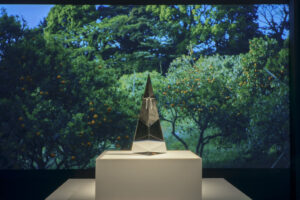
Fragrance of Infinity: Hiroshi Sugimoto’s limited edition perfume bottle
Copyright: Diptyque
In honor of Diptyque’s 60th anniversary, our client Hiroshi Sugimoto collaborated with the fragrance house on a limited edition perfume bottle inspired by the Japanese region of Kankitsuzan. The artist used his childhood memory of seeing the ocean for the first time to create a striking form exploring the relationship between man and nature. More information on the collection can be found here.
Public Art Commissions
In honor of Veterans Day, the People’s Picture (our client) was commissioned by America250 to create a digital photo mosaic depicting African American WWI hero Sgt. Henry Johnson for its November Salute 2021. The stunning mosaic, containing hundreds of photographs of veterans and other military personnel, is accessible online here and you can read more about The People’s Picture and their work here.
Artists, Art Dealers & Art Fairs
A number of our artist-clients received recognition for international art exhibitions over the past year, including the talented Kamrooz Aram. In addition, our collector-clients and dealer-clients were also actively buying and selling art through both online platforms and in-person art fairs.
Television & Film
As television viewership numbers increase during the pandemic, it is a pleasure to work with producers, writers, and on-screen talent creating exciting programs. One of these clients is Terra Incognita, a company producing content for educational, travel, and documentary programming. They focus on high-quality and thought-provoking ideas to empower audiences around the world.
On behalf of Amineddoleh & Associates, we wish you a happy holiday season and wonderful new year.
by Amineddoleh & Associates LLC | Dec 6, 2021 |
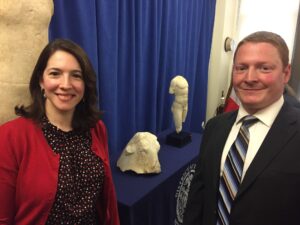
Our founder at the repatriation ceremony for the Bull’s Head in 2017
Today, the Manhattan District Attorney (DA) Cyrus Vance announced that Michael Steinhardt, hedge-fund pioneer and one of the world’s most prolific collectors of ancient art, surrendered 180 looted antiquities valued at $70 million. This unprecedented seizure is the result of a criminal investigation that began several years ago. Amineddoleh & Associates previously wrote about a looted Bull’s Head had been purchased by Steinhardt in 2010 for $700,000, who subsequently loaned it to the Metropolitan Museum of Art. After museum personnel raised concerns as to the provenance of the object, it came to light that the sculpture had been looted during the Lebanese Civil War. The Bull’s Head, as well as an ancient marble torso depicting a calf bearer, were both tied to the black market, seized by the DA’s Office, and subsequently repatriated. Both items had been extensively photographed during their excavation in 1967, and storage records placed them at a Lebanese warehouse before they were stolen in 1981. Notably, there was “not a single piece of paper” accounting for the provenance of the Bull’s Head between its disappearance and later sale at a London dealership in the 1990s.
Despite the presence of multiple red flags during the acquisition process, Steinhardt failed to prioritize due diligence when purchasing these objects. Most of the antiquities in his collection were trafficked during periods following civil unrest or armed conflict and depicted covered in dirt or other encrustations in photographs prior to their purchase. The seized objects span 11 countries and 12 criminal smuggling networks, and all had deficient provenance histories – or more troublingly, no information at all as to their origins – at the time of sale. It is incredulous that Steinhardt was unaware of his illegal acts. “For decades, Michael Steinhardt displayed a rapacious appetite for plundered artifacts without concern for the legality of his actions, the legitimacy of the pieces he bought and sold, or the grievous cultural damage he wrought across the globe,” said District Attorney Vance. “His pursuit of ‘new’ additions to showcase and sell knew no geographic or moral boundaries, as reflected in the sprawling underworld of antiquities traffickers, crime bosses, money launderers, and tomb raiders he relied upon to expand his collection.”
In a major announcement, the DA’s Office reached an agreement to put an end to the legal process filed against Steinhardt, whereby all the antiquities formerly in his possession will be returned to their countries of origin rather than being held as evidence in a lengthy criminal procedure. Vance also indicated that his office is currently carrying out joint parallel investigations with foreign law enforcement, and this measure will protect the integrity of the process and potential witnesses. Most importantly, Steinhardt was given a lifetime ban on the purchase of antiquities, the first time such an extreme sanction has been imposed. This indicates the seriousness with which the DA’s Office views the illicit trafficking of antiquities and other cultural heritage objects and heralds more stringent oversight for private players in the New York art market.
The Steinhardt seizure represents a significant achievement for the Manhattan DA’s Antiquities Trafficking Unit (led by Matthew Bogdanos), which has recovered thousands of stolen cultural heritage objects collectively valued at over $200 million since its inception in 2017, and repatriated a total of 717 pieces to 14 nations over the past year.
Amineddoleh & Associates LLC has been watching this matter closely. Our founder, Leila A. Amineddoleh served as the cultural heritage law expert for a number of the warrants used to seize dozens of items from Steinhardt’s collection, including the Lebanese Bull’s Head. (We note that Leila has never been, and is not currently, employed by the Manhattan DA’s Office, but has instead served as an independent expert.)
by Amineddoleh & Associates LLC | Nov 9, 2021 |
This entry in our ongoing Provenance Series addresses the phenomenon of unexpected archaeological discoveries and their role in spurring historical and cultural research.

Portrait of Richard III in the National Portrait Gallery
Archeologists often spend years digging for and uncovering cultural heritage artifacts around the world. These artifacts serve as windows into the past and are pivotal in piecing together the history of the world and its myriad cultures. Some famous discoveries, however, were found entirely by accident rather than by careful planning. For example, in 1974, a group of Chinese farmers digging a well struck the head of a clay figure with their shovels. The resulting excavation revealed an ancient tomb with thousands of life-size sculptures depicting horses and warriors in full armor and battle formation, guarding the remains of an emperor. We now know of the sculptures as the Terra Cotta Warriors. In 1947, a Bedouin goat and sheep herder searching for his lost goat happened upon a cave that contained papyrus scrolls later confirmed to be the Dead Sea Scrolls. These contain some of the earliest known writings from the Bible and new fragments are still being discovered today.
While some discoveries were unexpected because they were found by accident, other discoveries are shocking due to the location where they were found. The body of Richard III, a king from the Plantagenet line who ruled England during the medieval Wars of the Roses (and later inspired one of Shakespeare’s plays), was famously uncovered in a parking lot in Leicester in 2012, after a group of archeologists from the local university and members of the Richard III Society coordinated efforts to find his body. Previously, it was believed that Richard III had been buried in Greyfriars Church in Leicester, which was likely destroyed during the reign of Henry VIII.
Over the past few years, there have been several notable unexpected discoveries, including the following:
4,000-year-old Log Coffin in a Pond at an English Golf Course
A 4,000-year-old log coffin containing human remains and a “perfectly preserved ax” was discovered in a small pond at the Tetney Golf Club near Grimsby, England. The club owner’s feared that the discovery would hurt business, and the excavation team sought to obtain sufficient information about the artifacts. Hence, although the discovery was made in the summer of 2018, it was not announced until this past September.
Three years ago, workers on the golf course were using a large excavator to carry out improvements to the pond. Unexpectedly, it collided with a very large, hard object. The owners of the course notified local authorities and luckily Hugh Willmott, an archeologist and senior lecturer at the University of Sheffield, and his archeological team were working at a nearby excavation site. They were able to arrive at the golf course the next day to carry out rescue measures.
Over the past three years archeologists, historians, and conservationists have been completing preservation works on these fragile artifacts. The coffin is around three meters long and one meter wide and is believed to be from the Bronze Age (since log coffins are only known to have been used then). The man in the coffin was estimated to be tall for that time (5 foot 9 inches), approximately in his 30s or 40s at the time of death, and likely someone of great stature in his community. The axe is considered rare, as only 12 of this type have been discovered in Britain. It has a wooden handle and a stone head, and is believed a “symbol of authority” rather than a tool used in practice.
Given the size of the coffin, the conservation process is still under way. Once complete, the coffin and axe will be displayed at the Collection Museum, an art and archeological museum in Lincolnshire. The discovery has been called a “brilliant learning experience” and is expected to produce valuable information on ancient regional burial practices.
Roman Artifacts Discovered Under an Abandoned Medieval Church near London

A CGI image showing what St. Mary’s Church may have looked like when built. Image: courtesy of HS2
Less than 150 miles from the golf course, another major find was discovered. Earlier this month, a team unearthed three Roman statues and a rare glass jug as they concluded their dig at St. Mary’s Church in Stoke Mandeville, a town 46 miles outside of London.
The “once in a lifetime” and “uniquely remarkable” find included two full stone torsos and heads of an adult man and woman, and a stone head of what appears to be a child. The lead archeologist noted the exceptional preservation of the sculptures, commenting: “[Y]ou really get an impression of the people they depict—literally looking into the faces of the past is a unique experience.” In addition, the team also uncovered pieces of a very rare and surprisingly intact hexagonal glass jug, for which there is only one other comparable item; the other job was discovered in Tunisia and is now on display at New York’s Metropolitan Museum of Art.
The artifacts were discovered at the site of an ancient Norman church. Researchers believe this site might originally have been a Bronze Age burial site. It was then the site of a Roman mausoleum built during the Roman occupation of Britain. Finally, it served as the site of St. Mary’s church, which was erected around 1080 C.E, renovated in the 13th 14th, and 17th centuries, and eventually torn down in the mid-20th century. This site’s rich history has been at the center of other archeological discoveries, including 3,000 bodies at the burial site of the church, Roman cremation urns, and painted walls and roof tiles.
This dig, funded by the U.K.’s national Department of Transport, is one of 60 sites that will be excavated ahead of the construction of the new H2S high-speed railway. This new, controversial railway will connect the expanse of the United Kingdom, but some surveys suggest that there are nearly 1,000 potential excavation sites along the proposed 350-mile route. It remains to be seen whether other archaeological discoveries will come to light.
Subway Station Development in Rome Leads to Additional Discoveries
In Rome, archeologists have been excavating at Amba Aradam in preparation for a new subway station that will connect Rome’s city center to towns in the eastern perimeter of the metropolitan area. Because the subway line is being built over 100 feet below ground, this has allowed archeologists to excavate much deeper than usual and, as a result, make a number of significant discoveries.
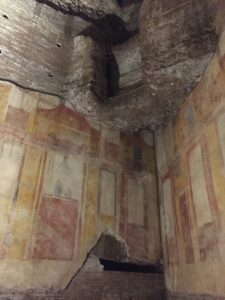
A Roman domus (not the one found under the subway station)
In 2016, the dig uncovered a military barrack from the 2nd C.E., during the rule of Emperor Hadrian. The find was so impressive that the government plans to create the city’s first “archaeological station.” Two years later, the team found a domus, or house, with a central courtyard, frescoed walls, patterned mosaic floors, a fountain, at least 14 rooms, rare wooden artifacts, and a similar sized structure 40 feet below ground, that is believed to have been used as a warehouse. This house likely belonged to the commander of the previously discovered military post. Given that the five-foot walls of the house were filled with dirt, researchers believe that it may have been buried intentionally in the third century, just prior to the construction of the walls of Rome in 271 C.E. As works on the subway line are ongoing, the likelihood of future discoveries remains a tantalizing possibility.
While some discoveries take place in the ground, some occur underwater.
Hoard of Roman Coins Found Along the Spanish Coast
In August 2021, two men on a family vacation were snorkeling when they came upon a stash of Roman coins – one of the largest of its kind ever discovered in Europe. The coins, dating back to the 4th-5th centuries C.E., had fallen into a rock crevice 20 feet underwater in Portitxol Bay by Xàbia, a popular tourist resort. The men removed eight coins with a Swiss Army knife and contacted the local authorities once they had inspected their find after surfacing. Authorities returned to the dive site with a team of underwater archaeologists from the University of Alicante and the Spanish Civil Guard. The team ultimately retrieved 53 coins, 3 nails and lead fragments (likely once part of the chest containing the hoard). The coins are in excellent condition, allowing researchers to read their inscriptions and identify the Roman rulers they depict. Rather than being lost in a shipwreck, the coins were probably hidden intentionally by a wealthy landowner to protect them from barbarian invaders during the decline of the Western Roman Empire. The individual most likely sank a boat in the bay with the intention of returning to claim his property but died before doing so. The coins will be restored and exhibited at the Soler Blasco Archaeological and Ethnographic Museum in Xàbia, while the regional government of Valencia is sponsoring further underwater excavations in the area.
Crusader Sword Discovered Off the Coast of Israel
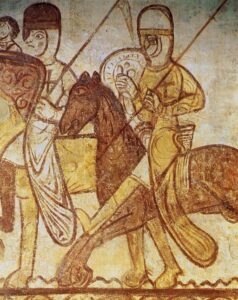
12th Century painting of a Crusader
In October 2021, an amateur diver found a 900-year-old sword dating back to the Crusades off the northern coast of Israel. The sword, as well as other ancient artifacts, became visible after sands shifted on the sea floor. It was covered in seashells, barnacles, and other forms of sea life but is otherwise preserved in perfect condition. The “beautiful and rare find” belonged to a knight, although further restoration is required to identify whether it is of Christian or Muslim origin, as they typically used swords of a similar size and shape. Since the sword was buried in a deep layer of sand and not exposed to oxygen, it avoided rust and other degradation. Archaeologists expect further artifacts to surface, particularly since the site was once a hotbed of mercantile activity. In the meantime, the sword has been taken to a scientific laboratory under the auspices of the Israel Antiquities Authority for cleaning and further research.
We hope you have enjoyed reading about these surprising archaeological discoveries. Amineddoleh & Associates continues to remain invested in the preservation of historical and cultural artifacts. You can access the other entries in our Provenance Series here and read about our firm’s services here.
by Amineddoleh & Associates LLC | Oct 29, 2021 |
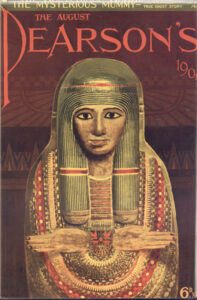
Cover of 1909 Pearson’s Magazine featuring the Unlucky Mummy
Just in time for Halloween, this spooky entry in our Provenance Series explores the strange case of the “Unlucky Mummy,” an ancient Egyptian artifact held by the British Museum since 1889 and rumored to have played a part in several tragic events during the last 150 years. The name of the object is misleading, as it is not an actual mummy, but rather a painted wooden “mummy board” or inner coffin lid depicting a woman of high rank. Mummy boards were placed on top of mummies, covered in plaster, and decorated elaborately with protective symbols of rebirth. The Unlucky Mummy was discovered in Thebes, an ancient hub for religious activity and the site of a renowned necropolis. It dates back to 950-900 B.C.E. While the lid does contain hieroglyphic inscriptions, these only refer to religious phrases; the identity of the deceased remains unknown. In the early 1900s, British Museum specialists believed that she may have been a temple priestess or a member of the royal family, but this was never confirmed by supporting evidence.
According to the museum’s records, the mummy board was originally acquired by an English traveler in Egypt during the 1860s-1870s. The mummy itself was most likely left in Egypt, since it has never formed part of the British Museum’s collection. The traveler was part of a group of Oxford graduates touring Luxor, who drew lots to haggle over the coffin lid. All four companions suffered unfortunate fates soon after this purchase. One of the men disappeared into the desert, one was accidentally shot by a servant and had his arm amputated, one lost his entire life’s savings, and one fell severely ill and was reduced to poverty. The mummy board then passed to the sister of one of the men, Mrs. Warwick Hunt, whose household became plagued by a series of misfortunes. When Mrs. Hunt attempted to have the coffin lid photographed in 1887, the photographer and porter both died, and the man hired to translate the hieroglyphs committed suicide. Clairvoyant Madame Helena Blavatsky allegedly detected an evil influence emanating from the mummy board, and convinced Mrs. Hunt to dispose of the object by donating it to the British Museum. Yet tales of the curse would follow. In 1904, journalist Bertram Fletcher Robinson published an article in the Daily Express titled “A Priestess of Death,” detailing the mummy board’s grisly exploits. When he died suddenly three years later, this was attributed to the Unlucky Mummy’s vengeance from beyond the grave. Even Sir Arthur Conan Doyle, the creator of Sherlock Holmes and avowed spiritualist, claimed that the mummy’s spirit had used “elemental forces” to strike down Robinson.
 One of the more sensational stories is that the mummy board was on the SS Titanic in 1912 and caused the ship to sink. However, this is only a rumor; the Unlucky Mummy has been on public display since the 1890s, except during WWI and WWII when it was placed in storage for safekeeping. It first left the British Museum in 1990 for a temporary exhibition at the National Gallery of Australia, and it made it back to London safe and sound. In fact, much of the mummy’s malevolent backstory was invented by English editor William T. Stead, who possessed a fascination with the supernatural. Ironically, Stead perished on the Titanic – but the Unlucky Mummy’s legacy lives on. It is allegedly responsible for multiple murders, illnesses, injuries, hauntings, eerie noises, flickering lights, and other suspicious activity.
One of the more sensational stories is that the mummy board was on the SS Titanic in 1912 and caused the ship to sink. However, this is only a rumor; the Unlucky Mummy has been on public display since the 1890s, except during WWI and WWII when it was placed in storage for safekeeping. It first left the British Museum in 1990 for a temporary exhibition at the National Gallery of Australia, and it made it back to London safe and sound. In fact, much of the mummy’s malevolent backstory was invented by English editor William T. Stead, who possessed a fascination with the supernatural. Ironically, Stead perished on the Titanic – but the Unlucky Mummy’s legacy lives on. It is allegedly responsible for multiple murders, illnesses, injuries, hauntings, eerie noises, flickering lights, and other suspicious activity.
For those who wish to see the Unlucky Mummy in person, it is currently located in Room 62 of the British Museum. Hopefully, its curse won’t follow you home…
by Amineddoleh & Associates LLC | Oct 26, 2021 |
 Today, the Gilbert Trust for the Arts in London announced the return a 4,250-year-old Anatolian gold ewer from the Gilbert Collection to Turkey. The Gilbert Collection was created by Arthur Gilbert (1913-2001), who amassed an outstanding collection of British and European decorative arts that is currently on long-term loan to the Victoria & Albert Museum (the V&A). Unbeknownst to Gilbert, the ewer was the product of illegal excavation and export. This came to light in 2019, after the Gilbert Trust for the Arts, which is responsible for managing the collection, performed an extensive provenance research project revealing the ewer’s connection to an unscrupulous antiquities dealer who concealed its true origins. Our founder, Leila A. Amineddoleh, played a role during this process as she shared her expertise in repatriation matters with the Gilbert Trust’s researchers and provided advice on what approach to adopt (based on legal and ethical grounds).
Today, the Gilbert Trust for the Arts in London announced the return a 4,250-year-old Anatolian gold ewer from the Gilbert Collection to Turkey. The Gilbert Collection was created by Arthur Gilbert (1913-2001), who amassed an outstanding collection of British and European decorative arts that is currently on long-term loan to the Victoria & Albert Museum (the V&A). Unbeknownst to Gilbert, the ewer was the product of illegal excavation and export. This came to light in 2019, after the Gilbert Trust for the Arts, which is responsible for managing the collection, performed an extensive provenance research project revealing the ewer’s connection to an unscrupulous antiquities dealer who concealed its true origins. Our founder, Leila A. Amineddoleh, played a role during this process as she shared her expertise in repatriation matters with the Gilbert Trust’s researchers and provided advice on what approach to adopt (based on legal and ethical grounds).
As a result of its discussions with the Turkish Ministry of Culture, the Gilbert Trust officially donated the ewer to the Museum of Anatolian Civilizations in Ankara and commissioned a leading contemporary metalsmith to create a piece addressing the object’s history, to be displayed at the V&A in December. This recreation will allow the ewer to remain present in the museum’s galleries and initiate a constructive dialogue on the importance of proactive provenance research, collaboration, and exchange. While other institutions are sometimes wary of repatriating objects without a legal requirement to do so, the Gilbert Trust’s actions demonstrate that it is possible to return cultural objects in a way that is both respectful to current possessors and takes the source country’s wishes into consideration, leading to a mutually beneficial solution.
The Ewer’s Provenance
 Not only is the ewer a stunning example of ancient metalwork, it also possesses a fascinating history. This masterpiece was created by a Hattian goldsmith living in Anatolia over 4,000 years ago. The ewer was formed by embossing a single sheet of gold with complex patterns, including an ancient symbol of the sun, in order to accompany a Hattian ruler into the afterlife. When Gilbert acquired the ewer in 1989, he was dazzled by the evocative story as well as its beauty. However, because Gilbert was not very experienced in collecting these types of objects (this was the only archaeological object he ever bought), the seller was able to conceal the ewer’s illicit origins and misrepresent the origins of the piece.
Not only is the ewer a stunning example of ancient metalwork, it also possesses a fascinating history. This masterpiece was created by a Hattian goldsmith living in Anatolia over 4,000 years ago. The ewer was formed by embossing a single sheet of gold with complex patterns, including an ancient symbol of the sun, in order to accompany a Hattian ruler into the afterlife. When Gilbert acquired the ewer in 1989, he was dazzled by the evocative story as well as its beauty. However, because Gilbert was not very experienced in collecting these types of objects (this was the only archaeological object he ever bought), the seller was able to conceal the ewer’s illicit origins and misrepresent the origins of the piece.
In fact, Bruce McNall – the antiquities dealer who sold the work to Gilbert – later admitted to smuggling ancient artifacts out of source countries like Italy, Greece and Turkey. He worked alongside his partner, Robert E. Hecht, to sell items to unsuspecting buyers. McNall is a colorful figure who once owned Thoroughbred racehorses as well as sports teams (the Los Angeles Kings of the National Hockey League and the Toronto Argonauts of the Canadian Football League), enjoying a great deal of commercial success. However, his fall from grace in the early 1990s after defaulting on a $90 million loan resulted in bankruptcy and a 6-year stint in prison. McNall’s autobiography, published in 2003, details his partnership with Hecht and offers a glimpse into the world of illicit antiquities trafficking. According to the book, at one point Hecht occupied the dubious honor of being the world’s largest source of recently discovered antiquities, which he was able to procure thanks to monetary resources and an extensive network of grave robbers, smugglers, and intermediaries. Once items were obtained, they passed through countries without export controls and then onto Hecht, who sold them on to a collector or dealer. In order to sell the illusion that an item’s provenance was above board, Hecht would spin tales about its location in private homes and the like for the past several decades. As his reputation – and notoriety – increased, buyers would come to Hecht knowing that he could procure rare and valuable pieces. This included McNall, who later opened a gallery on Rodeo Drive in Los Angeles supplied mainly by Hecht’s dubious dealings. Both men drove the market for ancient art amongst the wealthy, creating false sales receipts and invoices from foreign-based companies (usually set up by McNall and Hecht) to cover their tracks.
Notably, Hecht was also tied to the Euphronios Krater later returned to Italy by the Metropolitan Museum of Art. In 2005, Hecht was charged with trafficking in looted antiquities alongside former Getty Museum curator Marion True and Italian dealer Giacomo Medici, but the case was dismissed in Italian court because the statute of limitations expired before the verdict was issued. He moved to Paris in the wake of the scandal, where he eventually passed away in 2012 – although his legacy lives on in the remaining looted objects that passed through his hands and are dispersed throughout the world.
The Importance of Provenance Research
During the period when McNall and Hecht were active, provenance research was not given the same importance it holds today. For the majority of purchasers, including museums, not asking in-depth questions about provenance or looking the other way when confronted with suspicious ownership histories was considered the norm. However, nowadays museums and private collectors increasingly acknowledge the crucial role of provenance research in upholding the legitimacy and ethical role of cultural institutions as stewards for the public.
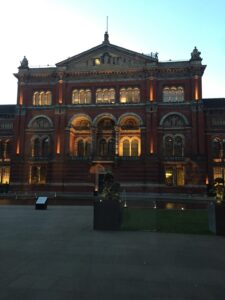 It is commendable when a collection proactively engages in discussions with foreign entities to right a past wrong. By following this course of action, it is possible for all stakeholders to determine the best outcome for displaced antiquities, without resorting to contentious and costly litigation (an expense that is burdensome for both private institutions and government entities). As such, creative results are possible, as in the Gilbert Trust’s agreement with Turkey. The Gilbert Trust made the decision to engage in proactive discussions with Turkey, a nation known to aggressively protect its cultural heritage and demand the repatriation of looted objects. However, by digging deeper into its collection to understand their histories, the ewer will finally return to its home, the Gilbert Collection will retain its unblemished reputation, and the V&A is engaging the public in discussions concerning ownership, history, and museum ethics.
It is commendable when a collection proactively engages in discussions with foreign entities to right a past wrong. By following this course of action, it is possible for all stakeholders to determine the best outcome for displaced antiquities, without resorting to contentious and costly litigation (an expense that is burdensome for both private institutions and government entities). As such, creative results are possible, as in the Gilbert Trust’s agreement with Turkey. The Gilbert Trust made the decision to engage in proactive discussions with Turkey, a nation known to aggressively protect its cultural heritage and demand the repatriation of looted objects. However, by digging deeper into its collection to understand their histories, the ewer will finally return to its home, the Gilbert Collection will retain its unblemished reputation, and the V&A is engaging the public in discussions concerning ownership, history, and museum ethics.










 One of the more sensational stories is that the mummy board was on the SS Titanic in 1912 and
One of the more sensational stories is that the mummy board was on the SS Titanic in 1912 and  Not only is the ewer a stunning example of ancient metalwork, it also possesses a fascinating history. This masterpiece was created by a Hattian goldsmith living in Anatolia over 4,000 years ago. The ewer was formed by embossing a single sheet of gold with complex patterns, including an ancient symbol of the sun, in order to accompany a Hattian ruler into the afterlife. When Gilbert acquired the ewer in 1989, he was dazzled by the evocative story as well as its beauty. However, because Gilbert was not very experienced in collecting these types of objects (this was the only archaeological object he ever bought), the seller was able to conceal the ewer’s illicit origins and misrepresent the origins of the piece.
Not only is the ewer a stunning example of ancient metalwork, it also possesses a fascinating history. This masterpiece was created by a Hattian goldsmith living in Anatolia over 4,000 years ago. The ewer was formed by embossing a single sheet of gold with complex patterns, including an ancient symbol of the sun, in order to accompany a Hattian ruler into the afterlife. When Gilbert acquired the ewer in 1989, he was dazzled by the evocative story as well as its beauty. However, because Gilbert was not very experienced in collecting these types of objects (this was the only archaeological object he ever bought), the seller was able to conceal the ewer’s illicit origins and misrepresent the origins of the piece. It is commendable when a collection proactively engages in discussions with foreign entities to right a past wrong. By following this course of action, it is possible for all stakeholders to determine the best outcome for displaced antiquities, without resorting to contentious and costly litigation (an expense that is burdensome for both private institutions and government entities). As such, creative results are possible, as in the Gilbert Trust’s agreement with Turkey. The Gilbert Trust made the decision to engage in proactive discussions with Turkey, a nation known to aggressively protect its cultural heritage and demand the repatriation of looted objects. However, by digging deeper into its collection to understand their histories, the ewer will finally return to its home, the Gilbert Collection will retain its unblemished reputation, and the V&A is engaging the public in discussions concerning ownership, history, and museum ethics.
It is commendable when a collection proactively engages in discussions with foreign entities to right a past wrong. By following this course of action, it is possible for all stakeholders to determine the best outcome for displaced antiquities, without resorting to contentious and costly litigation (an expense that is burdensome for both private institutions and government entities). As such, creative results are possible, as in the Gilbert Trust’s agreement with Turkey. The Gilbert Trust made the decision to engage in proactive discussions with Turkey, a nation known to aggressively protect its cultural heritage and demand the repatriation of looted objects. However, by digging deeper into its collection to understand their histories, the ewer will finally return to its home, the Gilbert Collection will retain its unblemished reputation, and the V&A is engaging the public in discussions concerning ownership, history, and museum ethics.